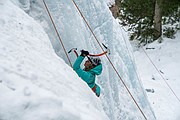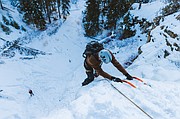Ascending ice
There’s a certain satisfaction that comes with a solid ice tool placement.
Hanging along a 50-foot wall of vertical ice, I lift my right arm above my head and strike the pick of the tool in a small concavity above me.
Looking down, Joel Anderson belays me with a smile.
This experience, the satisfaction of ascending columns of blue ice for the first time, is what Anderson is all about.
Anderson recently started Whitefish Vertical Adventures, an ice climbing guide business that aims to introduce winter adventurers to the niche sport.
For those unfamiliar with the sport, as I was when I moved to Whitefish nearly three years ago, ice climbing is similar to rock climbing in its goals, but different in its means.
Climbers ascend a pitch of ice, with someone below belaying them with a rope, using tools with sharp ice picks and crampons, spikes that attach to boots.
It’s a sport of ice chips in your face, exposure to the cold and the “screaming barfies” — the painful sensation of intense pain in the hands and nausea caused by the cold and limited circulation while climbing.
Anderson got his first crack at climbing ice in New Zealand six years ago during a guided course on the Fox Glacier on the country’s South Island.
“We did some easy warm up climbs, and then they lowered us into a crevasse and we had to climb back out,” he recalls. “It was such a cool first experience. And after that I was like, ‘Man, I need to get into this.’”
“I’ve been swinging tools for five seasons now,” he adds.
At Whitefish Vertical Adventures, Anderson offers full day climbs starting at $290 and half days starting at $190. Climbs take place at Serenity Falls near Marion, Bad Rock Canyon near Columbia Falls and Stone Hill near Eureka, though the latter is closed this year.
Anderson, a former ski instructor and coach at the Ridge Mountain Academy, said he’s been considering guiding for a while.
Ridge is a campus-based gap year enrichment program that revolves around mountain sports. When Ridge chose not to operate this year, the timing seemed right for a big leap, he says.
“It was me just twiddling my thumbs and thinking about what I was going to do this year and this winter. Owning my own guiding service has been in the back of my mind for a while, but I wasn’t sure exactly how to go about it,” Anderson says. “Ridge helped me out with all their old ice climbing gear, so I was able to get gear for a good price, and after that part it was like, ‘OK, I can do this.’”
In his first year of business, the winter hasn’t been ideal for guiding, Anderson says.
With a dry fall and a warm December, some of his primary locations haven’t come to fruition in terms of ice formation, and he’s still getting people to learn about his business.
Since things cooled down, however, he’s been taking out multiple clients a week, including photographer and social media influencer Alex Strohl, who posted about his experiences on his Instagram account.
With anyone, including me, Anderson starts from the beginning.
“When taking someone out that doesn’t have any climbing experience at all, we start at the very beginning. Even before we get to rope work, we’re talking about gear and how it works, then just walking in crampons, standing at the base of the ice and swinging the tool into it,” he says. “Ice climbing is all about efficiency and conserving energy. That’s a main focus right off the bat, because you’re using brand new muscles they’ve never used.”
He’s had a variety of clients so far, he says.
In one case, he had a couple out of Canada that were very experienced ice climbers looking to get their fix in the Flathead.
Another day, he took out a couple that had never even rock climbed in a gym.
For those who know little or nothing about ice climbing, the sport can seem daunting and terrifying. But in any scenario, Anderson says safety and enjoyment guide how he operates.
“A misconception with ice climbing is that it is dangerous,” he says. “Yes, there is an element of risk in anything we do outside. I take certain precautions and mitigations when ice climbing that creates a safe environment for whoever I’m taking. I’m the first one rappelling down. As I’m going down I’m inspecting the ice — how has it changed, has it formed differently, are there new features? And from that I can judge the best places for us to climb.”
And with his background in teaching skiing and snowboarding, Anderson says the experience of sharing his own passions is his favorite part.
“I’ve taught probably 1,000 ski lessons of all levels and abilities, and I feel like a lot of that translates to guiding,” he says. “It’s really rewarding for me to show people something new, something that I’m really passionate about. It’s very rewarding for me to see their hard work pay off.”
More information on Anderson and Whitefish Vertical Adventures is available at www.whitefishvertical.com.






